CHAPTER 3h: ALPHABETICAL LIST OF PLANT FAMILIES
WITH INSECTICIDAL AND FUNGICIDAL PROPERTIES
| SOLANACEAE
Solanum nigrum L. (Black/Deadly/Common Nightshade, Wonderberry, Prairie Huckleberry, Morelle Noire, Schwarzer Nachtschatten) |
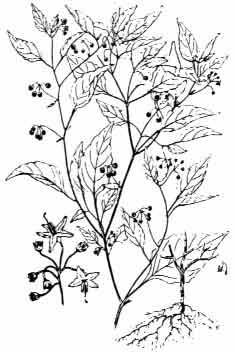
|
Perry, 1980; Duke, 1985; Kingsbury,
1964; Schauenberg and Paris, 1977
|
| Description | Annual, 10-30 cm tall; stems purplish, leaves simple, ovate to lanceolate with a pointed apex and a dentate purple margin. Flowers white with yellow anthers; berry black when ripe. | Schauenberg and Paris, 1977; Kingsbury, 1964 |
| Habitat | Native to Europe, introduced into
North America.
Very common on disturbed ground and waste areas, banks and cultivated areas. |
Kingsbury, 1964
Schauenberg and Paris, 1977 |
| Uses | Leaves, shoots and seeds used
in Chinese medicine.
Fruits of some strains are eaten in pies and used for making preserves; young shoots and leaves used as a pot herb; all parts of plant used medicinally. |
Perry, 1980
Duke, 1985 |
| Crude ethanol leaf extract | Ten percent (w/v) of leaf extract when applied topically significantly reduced survival of adult A. obtectus, S. oryzae and P. truncatus. | Niber, et al. 1992 |
| Constituents | Reported constituents include
solanine, saponin, oil, dihydroxystearic, linoleic, tetrahydroxystearic,
palmitic and stearic acids.
Roots, shoots and mature fruits are low in alkaloids but green fruits contain solanine. Solasodine, solasonine, solamargine, b -solamargine and a -b -solansodamine, solanigrine, gitogenin, traces of saponins, tannin (7-10 percent), diosgenin (0.4-1.2) and solasodine (0.09-0.65 percent). Also include heterosides derived from spirosolane, solasonine, solamargine and solanigrine (alkaloids). |
Perry, 1980
Duke, 1985
Oliver-Bever, 1986 |
| Toxicity | Mortality or severe posioning reported in cattle, chickens, horses, sheep and swine. Solanine is reported to exhibit teratogenic properties. Doses of 200-400 g of solanine will induce in humans gastroenterosis, tachycardia, dyspnea, vertigo, sleepiness, lethargy, twitchin and cramps. Other sympoms include diarrhea, mydriasis, panic, excitation, coma, hyperthermia, dazed state, paralysis, rarely fatality due to respiratory difficulty and hypothermia. | Duke, 1985 |
| SOLANACEAE
Withania somnifera Dun. (Winter Cherry) |
|
Uphof, 1968; Chander and Ahmed,
1982
|
| Description | Shrub, 60-120 cm in height, dull green, oval leaves, 3-10 cm; several small, stalked, yellow bell-shaped flowers in leaf axils. Corolla about 5 mm; calyx enlarged to 1-2 cm with star shaped hairs. Berry shining red. | Polunin, 1980 |
| Habitat | Africa, Mediterranean region ant Asia also found in Northern Nigeria. | Uphof, 1968; Daziel, 1937 |
| Uses | Berries used as soap; leaves and root used in traditional medicine. | Daziel, 1937 |
| Petroleum ether extract of roots. | 0.1 percent (v/w) admixed with green gram gave almost complete protection for up to 90 days against damage caused by C. chinensis. | Chander and Ahmed, 1982 |
| VERBENACEAE
Clerodendron siphonanthus R. Br. |
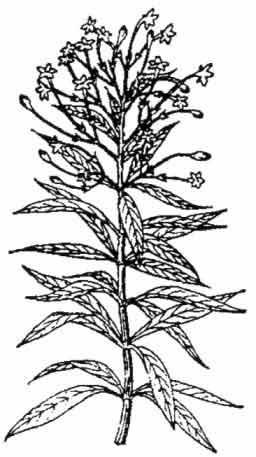 |
|
| Description | ||
| Habitat | ||
| Uses | Roots and leaves are used to treat asthma in Burma and Java. | Perry, 1980 |
| Methanol extract | Five percent admixed with wheat grain resulted in 100 percent adult mortality of S. oryzae six days after application. | Roychoudhury, 1993 |
| VERBENACEAE
Lantana camara L. (Lantana, Aripple, Wild sage, Yellow sage)
|
|
Oliver-Bever, 1986
|
| Description | A rambling, prickly stemmed, hairy shrub, evergreen, from 1.2-3 m high; leaves opposite or whorled, simple, oval or oval-oblong with pointed tips, toothed edges, many veins giving a wrinkled appearance. Flowers axillary, stalked, grouped in round heads about 2.5-5 cm across; variously coloured, pink or yellow changing with age to red or orange. | Perry and Hay, 1982 |
| Habitat | Tropics and subtropics; coastal locations. | Dalziel, 1937 |
| Uses | This plant is used as a traditional medicine in Nigeria and Senegal. | Oliver-Bever, 1986 |
| Extract | A deposit from a 5 percent solution applied to a glass container caused 40 percent mortality in adult C. chinensis within seven days. Application of 40 mg/100 g gram prevented oviposition. | Saxena, et al. 1992 |
| Volatile oil | 20 m l was applied to 1 cm2 filter paper, the paper disk was hung in jars containing 50 cowpeas. Females of C. maculatus laid 34 percent fewer eggs than on the control seeds after 15 days. | Gbolade and Adebayo, 1993 |
| Dried leaves | 3 percent (w/w) admixed with wheat reduced oviposition (4.5 eggs), adult emergence (7.3 insects) and prolonged development of R. dominica (66.6 days) with regards to the control (17.1 eggs, 77.3 insects and 40 days respectively). | Singh, et al. 1996 |
| Constituents | Leaves, stems and flowers contain
the triterpenes a -amyrine, b
-sitosterol, lantadene B and rehmannic acid.
Leaves contain lanthanine (or lantadene A) (0.2-0.7 percent), lantadene B (0.2 percent), icterogenin and essential oil (0.05-0.2 percent). Essential oil contains citral and other sesquiterpenes, caryophyllene (up to 80 percent), a -phellandrene (10-12 percent), dipentene, terpineol, geraniol, linalool, cineole, eugenol, fufural and phellandrene. Also contain tannins, resins, dyestuffs, reduced sugars, lantadene (1.7 percent), methyl-3-oxo-ursulate, lantonol acid and lantanic acid. |
Oliver-Bever, 1986
Duke, 1985
Duke, 1985 |
| Toxicity | Human fatalities have been attributed to ingestion of green fruits. | Duke, 1985 |
| VERBENACEAE
Lippia geminata HBK. (Wild sage) |
Photograph unavailable
|
Uphof, 1968 |
| Description | Herb or sometimes shrub, with numerous slender branches, densely pubescent with mint like odour. Leaves 2-7 cm long, ovate or obovate, cineate to the petiole, evenly serrate; young leaves whitish, heads subglobose or short oblong; fruit 2-3 mm long. | Long and Lakela, 1973 |
| Habitat | West Indies, Mexico, South and Central America, West Texas. | Uphof, 1968 |
| Uses | Whole plant used as a fertiliser;
leaves have insecticidal properties; used against storage pests.
The plant is known to have medicinal properties. |
Grainge and Ahmed, 1988
Uphof, 1968 |
| Leaves | When 2 percent (w/w) was admixed with paddy rice in a choice-chamber trial and compared with untreated paddy rice, S. cerealella, R. dominica and S. oryzae adults showed a preference for F1 production on untreated rice. | Prakash and Jagadiswari, 1989 |
| VERBENACEAE
Vitex negundo L. (Wild sage, Lagundi, Nishinda, Begunia, Huangjing)
|
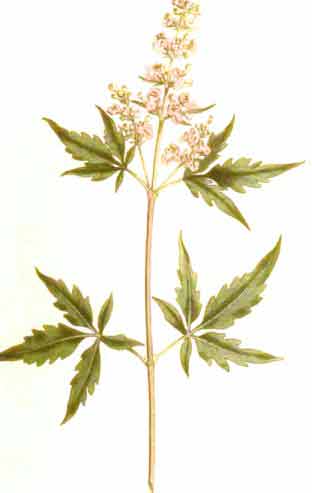 |
Perry, 1980
|
| Description | A common shrub or small tree found in moist areas, often on banks of rivers throughout India up to an altitude of 1 500 m. | Sukumaran and Kandasamy, 1988 |
| Habitat | Tropical and semi-tropical countries (Sir Lanka, Burma, China, Philippines, Malaysia, Tropical Africa, Afghanistan, Madagascar and Pakistan). | Sukumaran and Kandasamy, 1988 |
| Uses | This is used as a traditional
medicine in China, Indo-China, Indonesia and the Philippines.
In the Tamil Nadu region of India farmers mix a handful (4-10 percent) of leaves with stored grain to protect against insect damage. |
Perry, 1980
|
| Oil
|
Exposure to a combination of citronella
and lagundi oil (1:1) in a fumigation flask caused knockdown of adult S.
cerealella. (No figures were given).
250 mg/kg admixed with maize or mung bean resulted in 20 percent, 35 percent and 45 percent adult mortality in S. zeamais, R. dominica and C. chinensis respectively after an exposure period of 24 hours. |
Krishnarajah, et al.
1985
|
| Leaves | One percent admixed with freshly
harvested paddy, field-infested with S. cerealella, significantly
reduced the number of emerging F1 adults during four months of storage.
One percent (w/w) admixed with wheat did not reduce adult mortality or percentage damage by S. oryzae after an exposure period of 14 days. Two percent (w/w) admixed with either maize or mung bean caused 5 percent, 6.7 percent and 23.3 percent adult mortality in S. zeamais, R. dominica and C. chinensis respectively after a 24 hour exposure. Two percent admixed with milled rice did not reduce the rate of development of C. cephalonica larvae. |
Dakshinamurthy, 1988
|
| Three percent admixed with black
gram reduced damage by natural infestations of C. chinensis significantly
during a nine month storage period.
Three percent (w/w) admixed with wheat reduced oviposition (3.1 eggs), adult emergence (nine insects) and prolonged development of R. dominica (50.7 days) with regards to the control (17.1 eggs, 77.3 insects and 40 days respectively). Admixture of 5 percent (w/w) leaves did not significantly reduce the percentage of infestation and damage by S. zeamais on maize, relative to the control, during a six month storage period. Five percent (w/w) admixed with maize reduced percentage weight loss (10.9 percent) by S. zeamais when compared to the untreated control (37.2 percent). 5 mg/50 g mung bean caused 80 percent mortality in adult C. chinensis within 48 hour and prevented egg laying. |
Prakash and Jagadiswari, 1989
Mia, et al. 1985
Morallo-Rejesus, et al. 1990 |
|
| Z-heptatriacontanone (isolated from leaves) | 400 mg/kg admixed with rice reduced
oviposition in S. cerealella, R. dominica and S. oryzae. |
Prakash, et al. 1990 |
| Constituents | The leaves contain an alkaloidal material; crystalline substances, apparently glucononitol; p-hydroxybenzoic acid (responsible for germicidal activity) and a second glycoside. | Perry, 1980 |
| ZINGIBERACEAE
Aframomum melegueta (Rosc.) K. Schum. (Melegueta pepper, Grains of Pleasure) |
Photograph unavailalbe
|
Rehm and Espig, 1991 |
| Description | Reed-like plant, 90-150 cm in height. The seeds are small, hard, oyster-shaped, red-brown in colour and shiny. Seeds taste aromatic and pungent like ginger and cayenne pepper. | Wren, 1975 |
| Habitat | Tropical West Africa; cultivated in house gardens. | Wren, 1975 |
| Uses | Used as a spicy masticatory in
West Africa.
Seeds used as a condiment. Also used as a stimulant; principally in veterinary preparations. |
Pal, et al. 1988
Uphof, 1968 Wren, 1975 |
| Powder | Admixed with maize, the powder caused mortality in adult S. zeamais within 24 hours (LC50 of 0.398 g/5 g maize). | Lale, 1992 |
| Constituents | Pungency of seeds is due to paradol (related to gingerol). | Uphof, 1968 |
| ZINGIBERACEAE
Alpinia galanga (L.) Willd. (Greater galangal, Galangal de l’Indes)
|
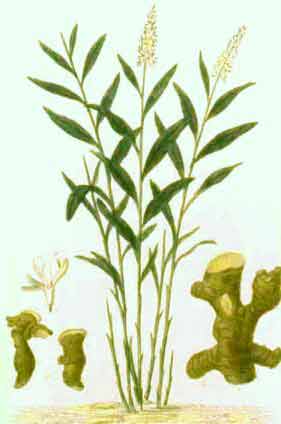 |
Perry, 1980 | |
| Description | Perennial aromatic herb growing to 2 m; white, red-lipped flowers and lance-shaped leaves. | Chevallier, 1996 | |
| Habitat | Native to grassland areas of Southern China and Southeast Asia. | Chevallier, 1996 | |
| Uses | This is a spice widely used in Malaysia and Java; it is also used for medicinal purposes. | Rehm and Espig, 1991 | |
| Oil | 0.5 percent (w/w) applied to green gram caused 100 percent mortality in adult C. chinensis within 15 days and prevented oviposition. | Ahmed and Ahamad, 1992 | |
| Powdered rhizome | Three percent (w/w) admixed with wheat caused 58 percent mortality in adult S. oryzae after 30 days compared to the control (29 percent). F1 emergence was reduced by 73 percent compared to the control. | Ahamad and Ahmed, 1991 | |
| Constituents | Rhizome reported to contain kaempferia, galangin, a volatile oil, and galangol (which yields cineole), pinene and eugenol. | Perry, 1980 | |
| ZINGIBERACEAE
Curcuma longa L. (Turmeric, Safran des Indes, Curcuma)
|
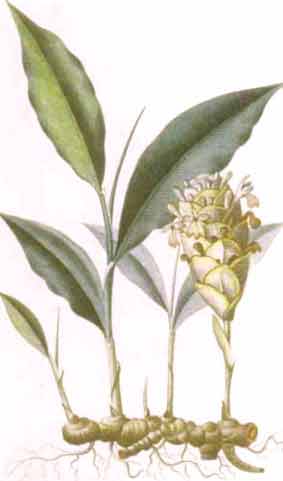 |
Rehm and Espig, 1991 |
| Description | Perennial, up to 90 cm; short stem; lance-shaped leaves; knobbly rhizome. | Chevallier, 1996 |
| Habitat | Native to India and Southern Asia; cultivated throughout Southern and Eastern Asia. | Chevallier, 1996 |
| Uses | The rhizome is used as a culinary spice and as a dye. Powdered turmeric at 2 percent admixed with grain is a traditional protectant of stored cereal grains in Pakistan and Southern Asia. | Rehm and Espig, 1991 |
| Rhizome powder | Two percent (w/w) admixed with
cowpea did not cause a significant reduction in oviposition and adult emergence
of C. maculatus after an exposure period of ten and 70 days respectively.
Three percent (w/w) admixed with wheat caused 53 percent mortality in adult S. oryzae compared to the control (29 percent) after 30 days. F1 emergence was reduced by 98 percent compared to the control. Four percent powder (w/w) admixed with rice and stored for six months reduced S. oryzae F1 progeny by 78 percent. At 1 percent (w/w), 50 percent suppression occurred at six months. Treatment of rice with a combination of turmeric powder at 2.5 g/kg and mustard oil at 4 ml/kg prevented the emergence of F1 adults for six months. |
Javaid and Poswal, 1995
Ahamad and Ahmed, 1991
|
| Plant powder | Three percent admixed with green gram caused 100 percent adult mortality and prevented oviposition in C. chinensis after 15 days exposure. | Ahmed and Ahamad, 1992 |
| Petroleum ether extract of rhizome | Extract applied to green gram
produced an LD5 0 for adult female
C. maculatus of 0.05 mg/kg, and an LD9
9 . 9 of 4.1 mg/kg, following
a 24 hour exposure period. Male insects were slightly more susceptible with
an LD 50 of 0.01 mg/kg and LD9
9 . 9 of 1.5 mg/kg.
680 m g/cm2 extract applied to filter paper produced Class IV (67 percent) repellency against T. castaneum, four weeks after application. |
Pranata, 1984
Jilani and Su, 1983 |
| Hexane (non-polar) and methanol (polar) extract | Contact toxicity studies determined both polar and non-polar extracts had no significant effects on adults of S. zeamais and T. castaneum. | Ho, et al. 1994
|
| Effects on commodity | A cooking trial of stored treated rice indicated that application of 4 percent (w/w) dried rhizome powder of C. longa admixed with rice produced no significant change in its taste and aroma. | Chander, et al. 1991 |
| Constituents |
Turmeric is known to contain pungent
odoriferous oils, oleoresins and other related compounds. The oleoresins
consist of curcumin and other related compounds. The chief components of
turmeric oil are sesquiterpene ketones in the form of turmerone and a
-turmerone.
Reported constituents include curcumin, turmerone, zingiberene, volatile oil, turmerol, phellandrene, carvone, camphor, curcumone, fat, starch, resin and curcumin (pigment). |
Jilani and Su, 1983
|
| Toxicology | A single acute dose treatment of 500 mg/kg body weight of a methanol extract of turmeric powder has been found to produce chromosomal aberrations in treated mice. The extract did not induce micronucleated polychromatic erythrocytes significantly. The authors suggested that the active clastogenic component of turmeric was possibly curcumin, which has been found to be clastogenic in cultured mammalian cells. Curcumin is generally found in turmeric at an average level of 3 percent, indicating that 0.003 g/kg body weight is potentially genotoxic. | Jain, et al. 1987 |
| ZINGIBERACEAE
Zingiber officinale Rosc. (Ginger, Ginembre, Gengibre) |
|
Rehm and Espig, 1991 |
| Description | Perennial herb growing to 60 cm
in height with lance-shaped leaves and spikes of white or yellow flowers.
Rhizome is source of ginger. |
Chevallier, 1996
|
| Habitat | Native to Asia; cultivated throughout the tropics. | Chevallier, 1996 |
| Uses | Ginger is used as a culinary spice, and as a traditional medicine in the West Indies and China. | Rehm and Espig, 1991 |
| Powdered rhizome | Two percent (w/w) admixed with
cowpea did not cause a significant reduction in oviposition and adult emergence
of C. maculatus after an exposure period of ten and 70 days respectively.
Three percent (w/w) admixed with wheat caused 56 percent mortality in adult S. oryzae in 30 days, compared with 29 percent in the untreated controls. The emergence of F1 adults was reduced by 60 percent compared to the controls. Three percent (w/w) admixed with green gram caused 58.8 percent adult mortality in C. chinensis after a 15 days exposure compared to the control (12.5 percent adult mortality). 2.5 g of powder admixed with 500 brown cowpeas reduced egg laying by adult C. maculatus and reduced the emergence of F1 adults by 96 percent compared to the untreated controls. |
Javaid and Poswal, 1995
Ahamad and Ahmed, 1991
Echendu, 1991
|
| Seed viability |
2.5 g of powder admixed with 500 brown cowpea seeds and stored for three months did not reduce seed viability. | Echendu, 1991 |
| Antifungal activity | Ten percent (w/v) of ground rhizome in rice powder and corn steep liquor medium prevented aflatoxin production of A. flavus after an incubation period of six days. | Mabrouk and El-Shayeb, 1980 |
| Constituents | Include the sesquiterpene zingiberene,
zingerone, b -camphene, b
-phallandrene, cineole, citral, borneol and zingiberol.
Methylheptenone, nonylaldehyde and linalool have also been reported. Other constituents include zingiberol, gingerol. The volatile oil contains mostly terpenes, phellandrene, dextrocamphene, the sesquiterpene zingiberene; zingerone, resins and starch. |
Ayensu, 1981
Jouhar and Poucher, 1991 Perry, 1980 |